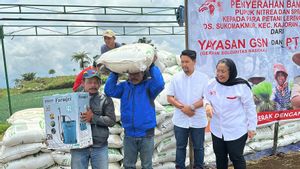JAKARTA - The Center for Climate and Atmospheric Research from the National Research and Innovation Agency (BRIN) is developing SADEWA. A disaster early warning information system related to extreme atmospheric conditions supported by remote sensing satellites and atmospheric dynamics models.
The extension of SADEWA is the Satellite Disaster Early Warning System (SADEWA). SADEWA is a disaster early warning information system based on satellite technology and atmospheric models.
This system serves to provide information to parties related to handling disaster events both at the central and regional government levels in the context of managing the risk of hydro-meteorological disasters.
"SADEWA is a web-based application consisting of a Himawari-8 satellite-based atmospheric monitoring system, a Weather Research Forecasting (WRF) model-based atmospheric prediction system, and an extreme rain early warning system," explained BRIN Center for Climate and Atmospheric Research researcher Anis Purwaningsih, quoted from the official BRIN website, Thursday, December 28.
SADEWA monitors atmospheric conditions in real time, predicts the possibility of extreme rain, and provides early warning information to parties related to disaster management. It includes information on atmospheric parameters such as rainfall, winds, clouds, temperatures and humidity.
For information, SADEWA 1, 1, began to be developed in 2010 as a pilot project for the West Java region which is prone to various disasters such as floods and landslides. Furthermore, the system has now been developed into the Sardehan 6.0 for Indonesian territory.
SADEWA covers the entire territory of Indonesia with a spatial resolution of 5 kilometers, a time resolution of 1 hour, with a prediction reach of the next 3 days. Sadives with a higher resolution (1 kilometer) are available for the West Java region with the same time resolution and prediction range as SADEWA 5 kilometers," continued Anis
Information accessible through SADEWA includes Cloud Peak Temperature, Water Steam, Visible, Near Infrared, Growing Clouds, Inter-tropic Convergence Zone (ITCZ), Monsun Index, IOD, MJO, SOI, ONI, AWS and Radar. As for the prediction for the next three days, users can access information related to Clouds, Rain, Surface Temperature, Pressure, Water Steam, 10 meters Wind, 850 millibar, and Wind 200 millibar. SADEWA can also provide early warnings of extreme rain.
"People can access SADEWA via, Sadawa.brin.go.id link for a resolution of 5 kilometers, while sadewa.brin.go.id/sadewabgr for a resolution of 1 kilometer," explained Anis.
On the SADEWA page, there are several choices of information features, including Rain, IR1, IR2, IR1-IR2, IR1-IR3, COM, and others. Of the many choices, some of the most important choices include Rain, IR1-IR2, IR1-IR3, and COM.
If you choose information about rain, you will see Indonesian territory and cloud cover. Maps can be enlarged to see a more specific location. You will see areas with black to gray cloud cover. The area covered by the clouds has the potential to experience rain from light to heavy intensity.
The choice of IR1-IR2 presents information about areas covered by Cirrus clouds (thins) or Cumulonimbus clouds. If your area is covered by Cumulonimbus clouds (dark green), the potential for your region will be flooded with rain. In the choice of IR1-IR3, it is shown that areas covered by high clouds (Cumulonimbus) are dark blue and low clouds (Culus). Just like the previous choice, if an area is covered by Cumulonimbus clouds, the region has the potential to experience heavy rain.
SADEWA itself is one of the tools used to predict weather. To obtain more accurate data, the public can cross-check other pages that have similar functions, such as those belonging to the Meteorology, Kilmatology and Geophysics Agency (BMKG).
The English, Chinese, Japanese, Arabic, and French versions are automatically generated by the AI. So there may still be inaccuracies in translating, please always see Indonesian as our main language. (system supported by DigitalSiber.id)









